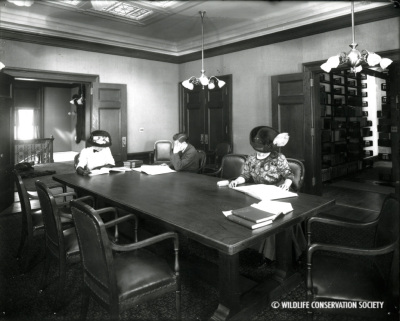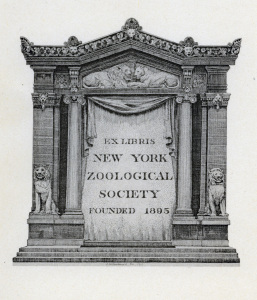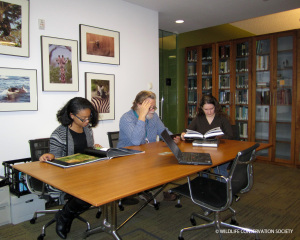 From its inception, the Bronx Zoo has been home to a library as well as to its many wonderful animals. In fact, in the first annual report, 1896 of the New York Zoological Society (today the Wildlife Conservation Society), gifts of books were solicited, “especially those on mammals, birds and reptiles, books of travel and exploration, and files of scientific journals in which zoological subjects have a place.”
From its inception, the Bronx Zoo has been home to a library as well as to its many wonderful animals. In fact, in the first annual report, 1896 of the New York Zoological Society (today the Wildlife Conservation Society), gifts of books were solicited, “especially those on mammals, birds and reptiles, books of travel and exploration, and files of scientific journals in which zoological subjects have a place.”
A library was planned as part of the new Administration building to be located on Baird Court (now Astor Court). This building was completed in 1910. And the Library remained there until it moved to the Center for Global Conservation, a short distance away, in 2009. At the same time that the Library opened in 1910, a member of the board of managers, Captain John S. Barnes, designed the lovely bookplate we still use today.
William T. Hornaday, the Zoo’s first director, believed strongly in the value of a library for Zoo staff and Society members. He provided much of the original collection, and when the holdings became disorganized and messy, he convinced the Zoo’s executive committee to allow the hiring of a professional librarian in 1919. Early annual reports provide information on the Library Fund, used to purchase materials for the Library. In 1919, for example, $105.45 was expended on periodical subscriptions. In 2014 dollars, that’s $1,450.89. Unfortunately, that amount wouldn’t cover many journal titles today, when a single journal subscription can cost more than $6,000 a year. According to the Twenty-third Annual Report of the New York Zoological Society, 1918, the goal of the Library Fund was to “assemble conservation literature so that it will become a complete reference library on the subject.”
The names of the earliest librarians are unknown, although H. Ernestine Ripley worked closely with Hornaday and was known for compiling a bibliography of the works of Henry Fairfield Osborn, who served as president of the New York Zoological Society in the early 1900s as well as the head of the American Museum of Natural History.
In the late 1970s, the Archives were created as part of the Library and a new librarian, also an archivist, was brought in to manage both collections. Steve Johnson created the basic Archives still existing today as well as providing library services to the growing staff of international conservation scientists in addition to the zoo and aquarium personnel.
The Association of Zoos and Aquariums has recognized the value and importance of zoo staff access to information. Its accreditation requirements include section 4.2.4:
“Institutions should provide staff access to informational resources with the goal of supporting excellence in programs, animal management, and exhibits. These resources may include a facility library, access to an offsite library or electronic access to internet resources.” [2015 Accreditation Standards and Related Policies,]
The WCS Library’s collection today still includes some of those titles that could be found in the early 1900s. It is not “a complete reference library” on conservation. Cost, space, and the explosion of literature, both in print and online, make that goal difficult to achieve.
But it continues its work to support WCS’s mission to save wildlife and wild places by offering access to several thousand books and over a thousand online journals, providing research services and training, and consulting with groups internally on managing information.
We look forward to continuing the tradition established at the very beginning of this historic institution.



